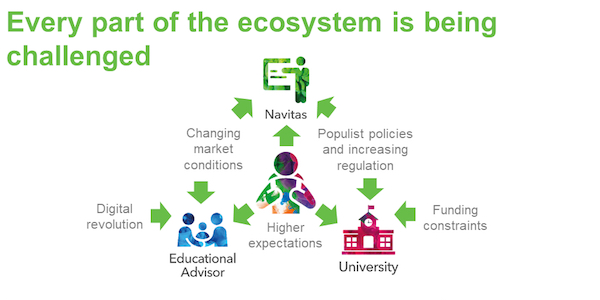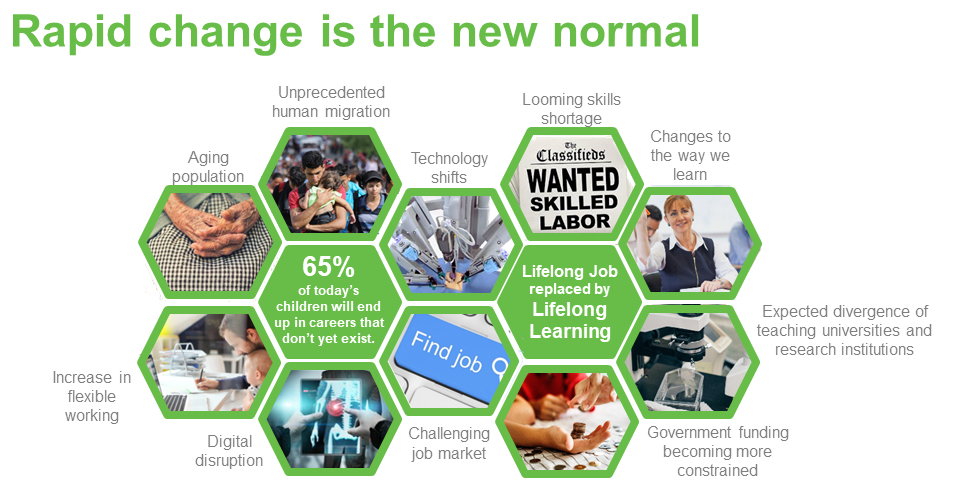
Reimagining the future of international education
One of the things I love most in my role is getting out and meeting the students whose lives are transformed by access to quality education. I am inspired by their commitment and passion, and humbled by their perseverance and resilience.
But their world, and the world they will shape in the future, is changing. At our recent Business Partners Conference in Colombo, I welcomed nearly 200 Navitas university partners and agents from more than 22 countries to discuss these changes, and consider how we can work together to remain relevant to the students we serve now and in the decades to come.
Adapting to change as it happens
Today’s student is already more digitally literate and better informed. They have higher expectations of teaching standards, accommodation, lifestyle – and most importantly, where their education will lead. They are more demanding, and more mobile. If we do not live up to their expectations they will vote with their feet.
I welcome this change, as it makes us more accountable to ensure we continually improve our service and quality.
We’re now seeing more students coming from within traditional destination countries such as Europe, Australasia and North America, while those that were once our primary source markets are quickly becoming education destinations in their own right – such as China and Russia.
Our enrolment data at Navitas reflects this decreasing reliance on China, and growth from South Asia, East Africa and the nations we know as the ‘’Stans”. Given our university partners prioritise campus diversity, this is also a positive change.
What is less positive is the impact of government rhetoric and regulation. International education is very sensitive to small tweaks to immigration rules, post-study work rights and assessment levels, while the rising influence of alt-right political sentiments (whether real or perceived) in many destinations affects the attractiveness of those countries – undermining even the best marketing efforts.
Students are far more informed before they reach out to educational advisors for help. They’ve already researched and engaged with their preferred institutions online, and they’ll shop around for an agent who can make that preference happen – expecting career and destination expertise, not just a vast selection of printed university brochures.
Many of our channel partners have adapted quickly to this opportunity, bundling additional services (such as flights, accommodation and even tutoring) with the standard visa and admissions counselling. Some are also extending the services they offer to include support for students once they have reached their destination.
Preparing for a very different future
These changes are all happening right now. But there is also more far-reaching disruption to consider.
For our next generation of graduates, the world of work will look very different. In 2017 the World Economic Forum predicted 65% of today’s children will end up in careers that don’t yet exist. Projections from the US Bureau of Labor list ‘professional tribers’, ‘neuro implant technicians’, ‘smarthome handyperson’ and ‘robot coach’, as some of the top 12 jobs in 2025.
This is driven by the economic transformation of the Fourth Industrial Revolution; by 2030, 375 million workers will be impacted by some form of automation through digitisation, artificial intelligence, robotics and networked cognition.
If jobs are changing, skills training will also need to change. The current model of front-loading education to ‘launch’ a career will no longer work once employability skills become so fluid. If today’s school leaver is expected to have 17 jobs over five careers in their lifetime, the concept of lifelong work will be replaced by lifelong learning.
Once we layer in demographic changes, including unprecedented human migration and the emerging middle classes in developing countries, the opportunity for international education grows even more. Over a billion students are expected to seek higher education and global training by 2030 – with expenditure reaching $10 trillion.
To meet this demand, two universities would need to be built every day until 2030, and millions of additional post-secondary teachers will be required. This is an impossible physical task – we can expect technology to help us provide the solution.
A welcome change in the way we work together
This future world doesn’t frighten me – it’s exciting. It opens up enormous opportunities for international education, and I believe Navitas and our partners can collectively be facilitators of this change.
We expect the number of agents to consolidate, but they will add more value to student experience through their digital strategies. Within universities, we expect to see a need for new revenue streams and a stronger focus on student outcomes – particularly employability.
In a climate of constrained Government funding, private providers, public institutions, agents and employers will all need to work together to meet these fundamental changes in student expectations and skills requirements. This is a journey Navitas is equipped to make – through our flexible partnerships and strategic relationships we have continuously evolved since establishing our first pathway program in 1994. We look forward to partnering with those who share our purpose: to provide more life-changing opportunities to learn, in an ever-changing world.





